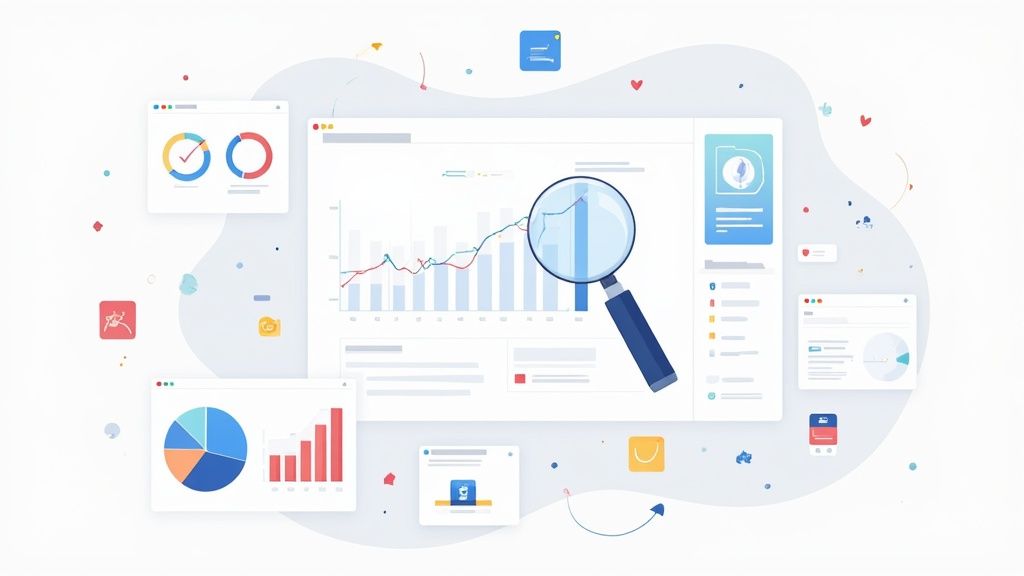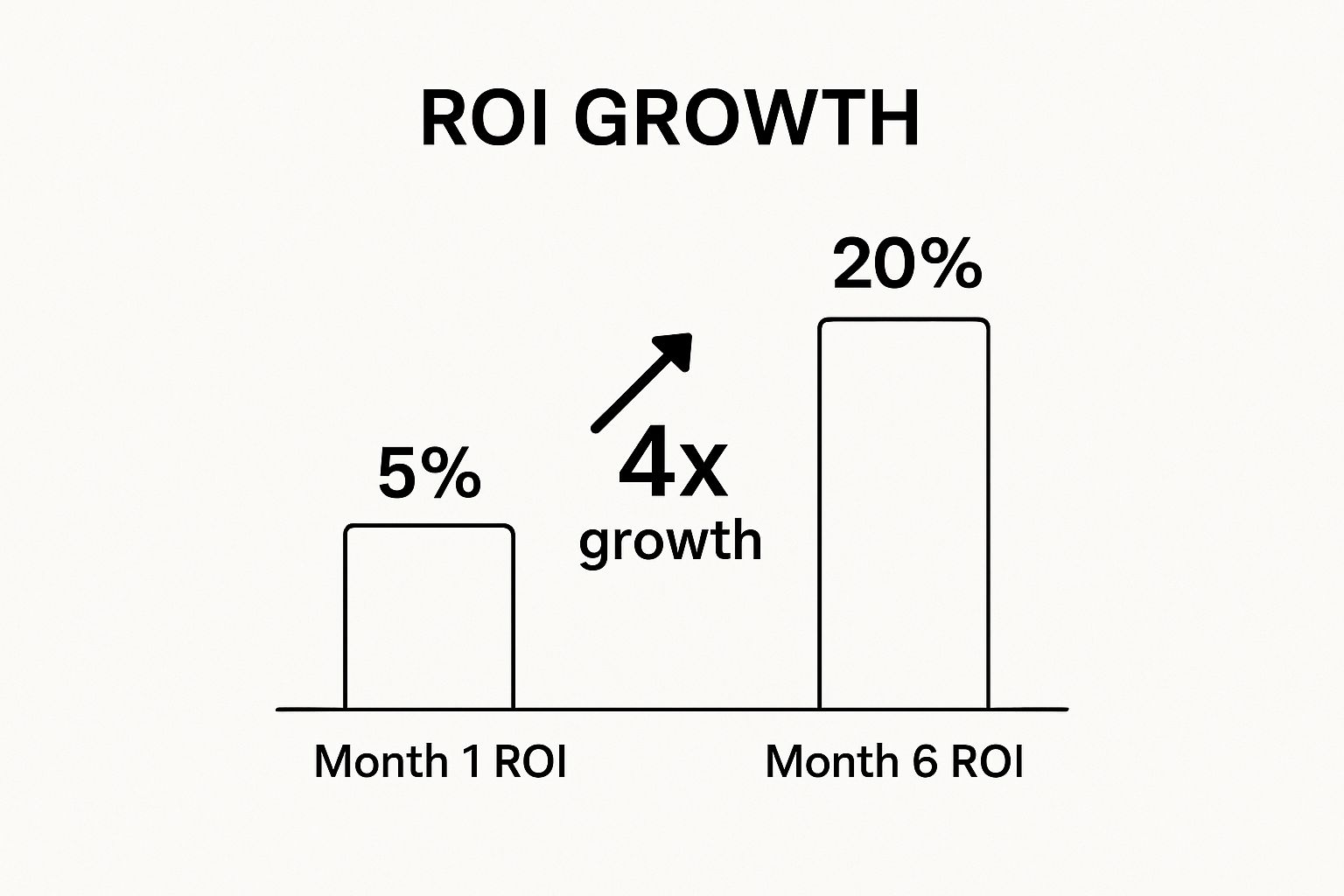Forget the old “spray and pray” days of traditional advertising. Pay-Per-Click (PPC) is a different beast entirely, built on a solid foundation of data that makes its return on investment potential massive. The real power behind PPC is its measurable results, giving you the incredible ability to see what’s working—and what’s not—in real time. This isn’t guesswork; it’s a calculated science.
Why Measurable Results Are Your PPC Superpower

When you run a PPC campaign, you’re not just buying clicks. You’re buying crucial data that sharpens every marketing decision you make from that point forward. Think about it: every single impression, click, and conversion is a direct signal from your audience. They’re telling you exactly what they’re looking for and how they feel about your message.
This constant feedback loop is what separates a good campaign from a great one. It gives you the power to stop throwing money at strategies that are falling flat. Instead, you can confidently shift your budget and double down on the ads, keywords, and audiences that are actually bringing in high-value customers. This direct line of sight into performance is a world away from the murky ROI of print or broadcast ads.
The Real Money in Tracking
The ROI numbers in PPC aren’t just hype. On average, businesses earn $2 for every $1 spent on Google Ads. That kind of return doesn’t happen by accident. It’s the direct result of continuous, data-fueled optimization. It’s no wonder that a staggering 93% of marketers consider PPC an effective channel—its success is built on a bedrock of tracking and analysis.
This ability to tie ad spend directly to revenue is what every business leader dreams of. You can walk into any budget meeting with hard numbers, showing stakeholders exactly how marketing is fueling the bottom line. It pulls emotion and guesswork out of the conversation and replaces them with cold, hard facts.
Key Takeaway: When you focus on measurable results, your ad budget stops being an expense and starts becoming a direct investment in acquiring new customers. This mindset shift is the first step toward building a highly profitable advertising machine.
The Metrics That Truly Drive ROI
Knowing which numbers to watch is everything. If you’re chasing vanity metrics, you’re just spinning your wheels. To really maximize your ROI, you have to focus on the key performance indicators (KPIs) that matter. For a deeper dive, check out our guide on how to improve marketing ROI.
To get started, let’s break down the essential PPC metrics you absolutely must track for accurate ROI analysis. These are the non-negotiables.
Foundational PPC Metrics for ROI Analysis
This table outlines the essential PPC metrics you must track to accurately measure and improve your return on investment.
| Metric | What It Measures | Why It’s Critical for ROI |
|---|---|---|
| Cost Per Acquisition (CPA) | The total cost to acquire one new customer. | This is your bottom-line efficiency metric. A low CPA means you’re acquiring customers profitably. |
| Return on Ad Spend (ROAS) | The total revenue generated for every dollar spent on ads. | This directly measures the profitability of your campaigns and answers the question, “Is this working?” |
| Conversion Rate | The percentage of ad clickers who complete a desired action (e.g., purchase, sign-up). | This tells you how effective your landing page and offer are at turning traffic into tangible results. |
By keeping a close eye on these KPIs, you gain the intelligence needed to make smarter, more profitable decisions. You’ll know exactly which ads to kill, which keywords are gold mines, and how to allocate your budget with surgical precision. It’s how you ensure every single dollar is working as hard as possible to grow your business.
Building a Tracking Foundation You Can Actually Trust

Let’s be honest: launching a PPC campaign without a solid tracking system is like driving a race car with a blindfold on. You’re burning fuel (and money) with no idea if you’re even on the track, let alone winning. To get measurable results, you need a setup that connects every click and every dollar spent directly to a real business outcome.
This isn’t just a technical prerequisite; it’s the very foundation of a profitable campaign. This infrastructure is what gives you the raw data to see what’s working and, more importantly, what’s not. It’s the only way to move from guesswork to making sharp, data-backed decisions that actually grow your business.
Get Your Core Tracking Pixels in Place
First things first, you have to install your conversion tracking pixels. These tiny snippets of code are the essential link between the ad platforms and your website. Think of them as your eyes on the ground, reporting back every time a user who clicked your ad does something you care about.
What does a “conversion” mean for you? For a B2B SaaS business, it might be a demo request. If you run an e-commerce shop, it’s a sale. You have to decide what a win looks like and then tell your pixels to watch for it.
The Must-Have Tracking Pixels:
- Google Ads Tag: If you’re on Google Ads, this is non-negotiable. It’s how you’ll see which keywords and ads are actually driving leads, sign-ups, or sales right inside your Google Ads account.
- Meta Pixel: For anyone advertising on Facebook or Instagram, the Meta Pixel is just as critical. It doesn’t just track conversions; it helps you build powerful retargeting audiences and lets the platform’s algorithm find more people likely to convert.
Getting these pixels installed correctly is the single most important step you can take. It’s the mechanism that proves your ad spend is generating real value and unlocks the true return on investment potential of your campaigns.
See the Entire Customer Journey, Not Just the Finish Line
Most visitors won’t convert on their first visit. The customer journey is rarely that simple. They might download an ebook, watch a product demo, or add an item to their cart and leave. We call these micro-conversions, and tracking them is crucial for understanding user intent.
This is where a tool like Google Analytics really shines. By setting up goals, you can monitor these smaller, yet significant, actions.
Let’s imagine you see a campaign driving tons of traffic where people watch your demo video but never sign up. That’s not a failure; it’s a massive clue. The ad is working—it’s attracting interested people! The problem might be on your landing page, which perhaps needs a clearer call-to-action to get them across the finish line.
For a deeper dive into structuring your data collection, our complete guide on marketing campaign tracking provides more detailed frameworks. Understanding the full path, from first click to final purchase, gives you the map you need to optimize every single step and build a truly repeatable PPC strategy.
Turning Campaign Data Into Actionable Insights

Once your tracking foundation is solid, the real work begins. Raw data is just noise until you give it meaning. Your ability to interpret this data is what separates a profitable campaign from a money pit. The goal isn’t just to look at the numbers, but to ask why things are happening.
This is how you unlock substantial return on investment potential. Instead of just counting clicks, you start diagnosing performance. For example, a keyword with a high click-through rate but zero conversions isn’t just a number—it’s a puzzle. And it’s your job to solve it.
Uncovering Your Best and Worst Performers
Your first mission is to dive into your Google Ads or Meta Ads reports and start segmenting. Looking at campaign totals is a rookie mistake; it hides all the important details. You need to get granular and analyze performance at the keyword, ad, and audience levels.
What you’re hunting for are the outliers. Which keywords are driving all your conversions at a low cost? And which ones are just eating your budget with nothing to show for it?
- Top Performers: These are your money-makers. The goal here is simple: protect and scale them. Can you push more budget their way? Could you build new ad groups around similar high-performing keywords?
- Underperformers: These demand immediate attention. Maybe you need to pause them entirely. Or perhaps refining their match types could do the trick. Don’t forget to ask if the ad copy or landing page is the real problem.
This kind of segmentation turns a confusing mess of data into a clear priority list. Suddenly, you have a strategic roadmap for what to fix and what to double down on.
By focusing on the granular details, you shift from just managing a campaign to actively steering it. Every optimization you make becomes a small, calculated move toward higher profitability, driven by hard evidence.
Diagnosing the High-Click, Low-Conversion Problem
Let’s tackle a classic and incredibly frustrating scenario: a keyword is getting tons of clicks, but no one is converting. Your measurable results show you’ve captured their interest, but something is falling apart before they cross the finish line. Since PPC provides advertisers with the ability to track and analyze campaign performance, it’s time to play detective.
First, check for a message mismatch. Does your ad promise “50% Off All Winter Boots,” but the landing page just dumps them on your general shoe collection? This disconnect is a primary cause of high bounce rates. The user clicked because they expected a specific offer, and when they didn’t find it, they left.
Next, put the landing page experience under a microscope. Is it slow to load? Is the form confusing or ridiculously long? On mobile, is the “Buy Now” button buried below the fold? Each of these friction points can absolutely kill your conversion rate.
This is where paid advertising really shines. You get detailed metrics like click-through rates (CTRs) and conversion rates to guide you. While an average CTR of around 3.52% is a decent start, getting the click is only half the battle. We know that PPC campaigns often convert 50% better than organic search traffic, so fixing these post-click issues is critical for capitalizing on that high-intent audience. If you’re curious, you can explore more about these industry benchmarks to see how you stack up.
By methodically investigating each touchpoint, from the ad to the thank you page, you can pinpoint the exact cause of the breakdown. This is how you transform raw data into powerful strategic intelligence that directly grows your ROI.
4 Advanced Strategies to Maximize Your PPC ROI
So, you’ve got your tracking in place and the data is flowing. This is where the real fun begins. Once you have a solid data foundation, you can move past the basics and start unlocking the kind of impressive gains that make PPC such a game-changer. These are the techniques that separate campaigns that just break even from those that become genuine, reliable profit centers for a business.
This isn’t just about pausing a few bad keywords. It’s about a commitment to continuous, proactive optimization—constantly hunting for new ways to boost efficiency and drive growth.
Just look at what a dedicated, data-driven approach can do. This is a real-world example of how strategic optimization can dramatically increase ROI in just a few months.

The takeaway here is simple: small, consistent adjustments based on performance data lead to compounding returns. A 5% ROI can become a 20% ROI—a 4x improvement—with steady, intelligent effort.
Master the Art of A/B Testing
One of the most powerful tools in your arsenal is A/B testing, or split testing. But let’s be clear: I’m not talking about testing fifty shades of blue on a button. To get meaningful results, you need to test the core elements of your campaign that actually influence a user’s decision.
Here’s what you should be A/B testing for maximum impact:
- Ad Copy Headlines: Test completely different value propositions. Does a headline screaming “Free Shipping” outperform one that calmly states a “5-Year Warranty“? The answer tells you exactly what your audience cares about most right now.
- Landing Page Offers: Pit a 20% discount against a “Buy One, Get One Free” offer. This isn’t just a test of numbers; it reveals your customer’s core buying psychology.
- Calls-to-Action (CTAs): Test “Get Your Free Quote” against “See Pricing.” This subtle shift in language can tell you volumes about how far down the funnel your audience is and their readiness to commit.
Remember, every test is a win. Even a “losing” test gives you invaluable information. You’re not just trying to find a better ad; you’re trying to gain a deeper, more nuanced understanding of your customer.
Make Your Bids Work Smarter, Not Harder
Let’s get one thing straight: not all clicks are created equal. A user searching for B2B software on a desktop at 2 PM on a Tuesday is in a completely different mindset than someone browsing on their phone late on a Saturday night. Strategic bid adjustments let you put your money where the conversions are.
Think about it. You can tell the ad platforms to bid more aggressively for users in specific locations, at certain times of day, or on particular devices. Use your campaign data to identify these high-value segments.
If you see that mobile users in Chicago are converting at twice the rate of anyone else, you can set a +40% bid adjustment for them. Conversely, if weekend traffic rarely converts, you can apply a -25% adjustment to conserve your budget. This automates the process of funneling your ad spend toward the most profitable clicks.
Choose the Right Bidding Strategy
Deciding between letting Google’s AI handle your bids and doing it yourself is a major strategic choice. Automated bidding has gotten incredibly sophisticated, but manual bidding still offers a level of granular control that some advertisers need. There’s no single “best” answer—it all depends on your goals, budget, and how much time you can dedicate.
Here’s a quick comparison to help you decide which approach is the right fit for your campaigns.
Manual vs. Automated Bidding Strategies
| Bidding Strategy | Best For | Pros | Cons |
|---|---|---|---|
| Manual CPC Bidding | Campaigns requiring tight control; advertisers with deep experience and time. | Total control over max CPC bids; quick reaction to market changes. | Time-consuming; can’t optimize in real-time like algorithms. |
| Enhanced CPC (eCPC) | A “hybrid” approach, giving you control with an AI safety net. | Adjusts manual bids for likely conversions; good for learning. | Less control than pure manual; can sometimes overspend. |
| Maximize Conversions | Getting the most conversions possible within your budget. | Fully automated; great for lead gen or sales volume focus. | Can result in high cost-per-conversion; no CPA target control. |
| Target CPA (tCPA) | Achieving conversions at or below a specific cost-per-acquisition. | Focuses on profitability; good for stable campaigns. | Requires significant conversion history to work well. |
| Target ROAS (tROAS) | E-commerce or lead gen where different conversions have different values. | Bids based on predicted revenue; directly optimizes for ROI. | Most data-hungry strategy; needs accurate conversion value tracking. |
Ultimately, many seasoned pros use a mix. You might start a new campaign with Manual or Enhanced CPC to gather data and maintain control, then switch to an automated strategy like Target CPA once you have a reliable stream of conversion data. Don’t be afraid to experiment to find what delivers the best ROI for you.
Scaling Success and Proving Value to Stakeholders
Getting a great return on one campaign feels good, but that’s just the first step. The real challenge—and where the big wins are—is figuring out how to replicate that success and scale it across all your advertising efforts. You need to turn a single victory into a predictable, growth-driving machine. This is where your data becomes your most powerful tool for storytelling.
When you’re reporting to your team, your boss, or your clients, you have to get past the surface-level stuff. Clicks and impressions are fine, but they don’t pay the bills. The focus needs to be on the metrics that directly impact the bottom line, presented in a way that everyone from the CEO down can immediately grasp.
Crafting a Narrative of Business Impact
Your performance story should have two main characters: Return on Ad Spend (ROAS) and Customer Acquisition Cost (CAC). These are the numbers that truly matter. ROAS answers the simple, critical question, “For every dollar we put in, how many are we getting back?” Meanwhile, CAC shows you precisely what it costs to bring a new customer through the door.
Showing these numbers isn’t enough; you need to show their journey. A dashboard that displays a consistently rising ROAS or a falling CAC over the past few months tells a compelling story. It’s visual proof of smart, strategic management.
The best reports I’ve seen don’t just dump data on you; they explain the why. You have to connect the dots. Show how your specific actions—like cutting a weak ad group or shifting budget to a top-performing audience—directly led to those positive changes in ROAS and CAC.
Making Confident, Data-Backed Scaling Decisions
Once you have a crystal-clear view of what’s actually profitable, you can stop guessing where to put your money. This feedback loop is what makes the return on investment potential substantial. Those measurable results you’ve been tracking are now your roadmap for growth.
Let’s say your analytics show that your video ads targeting mobile users are crushing it with a 5:1 ROAS. That’s not just a nice stat; it’s a bright green light telling you exactly where to scale up your budget. Conversely, if a specific search campaign has a stubbornly high CAC, you know it’s time to dig in and fix the problem before you even think about spending more on it.
Because PPC provides advertisers with the ability to track and analyze campaign performance, you have the power to make these calls with confidence. You’re not gambling; you’re making calculated investments.
To really get this right, check out our deep dive on how to accurately calculate return on ad spend. Adopting this data-first mindset ensures every dollar you spend is working as hard as it can, setting you up for consistent, long-term growth.
Your Top Questions About PPC ROI Answered
When you’re putting real money on the line for pay-per-click ads, you’re bound to have some questions. It’s only natural. Getting a solid grasp on how to track performance, measure profitability, and really understand the moving parts is what separates a successful campaign from a money pit. Let’s dig into some of the most common questions I hear from advertisers.
What Is a Good ROI for PPC?
This is the big one, but the honest answer is: it depends. There’s no magic number that works for everyone because a “good” return on investment is tied directly to your specific business, your profit margins, and what you’re trying to achieve.
That said, a widely accepted benchmark to aim for is a 4:1 ratio. This means you’re bringing in $4 in revenue for every $1 you spend on your ads. But again, context is everything.
A SaaS business with a high customer lifetime value might be thrilled with a lower initial ROI, knowing the real profit comes over months or years. On the flip side, an e-commerce shop with razor-thin margins needs a much higher return right away to stay in the black. Your first step should always be to figure out your break-even point and set your goals from there.
The real power of PPC is that you don’t have to guess. PPC provides advertisers with the ability to track and analyze campaign performance with incredible precision, so you can define exactly what a profitable ROI looks like for your business.
How Long Does It Take to See Results?
I get it—you want results, and you want them now. While you can get traffic and clicks almost immediately after a campaign goes live, seeing a positive ROI takes a bit more patience.
Think of the first few weeks as your data-gathering phase. You’re not necessarily aiming for profit just yet; you’re collecting the raw performance data you’ll need to make smart decisions.
Realistically, you should plan on 30 to 90 days before you have enough solid data to spot clear trends and start making meaningful optimizations. This is the point where you can confidently see which keywords are hitting the mark, which ad copy resonates, and which audiences are your money-makers. Jumping to conclusions after just a few days is one of the most common—and expensive—mistakes you can make.
Why Isn’t My PPC Campaign Converting?
This is probably the most frustrating problem to have. Clicks are rolling in, but the sales or leads just aren’t happening. When this happens, the problem almost always boils down to one of two things: your targeting or what happens after the click.
- Audience Mismatch: Take a hard look at your keywords. Are they too broad? You could be paying for clicks from people who are just browsing or doing initial research, not those who are ready to pull out their credit cards.
- Landing Page Disconnect: This is a huge one. Your ad makes a promise, but does your landing page follow through? If a user clicks an ad for “Men’s Waterproof Hiking Boots” and lands on a generic shoe page, they’re going to leave. Instantly.
Use your data as a diagnostic tool. A high click-through rate paired with a low conversion rate is a classic sign of a landing page problem. That’s your starting point. Test your headline, your offer, your call-to-action—test everything until you find what works.
Ready to turn your PPC data into actual, scalable growth? The experts at ReachLabs.ai specialize in building data-driven strategies that deliver real, measurable returns. Discover how we can elevate your campaigns today.





